Start JEEP COMPASS 2020 Owner handbook (in English)
[x] Cancel search | Manufacturer: JEEP, Model Year: 2020, Model line: COMPASS, Model: JEEP COMPASS 2020Pages: 328, PDF Size: 8.85 MB
Page 212 of 328
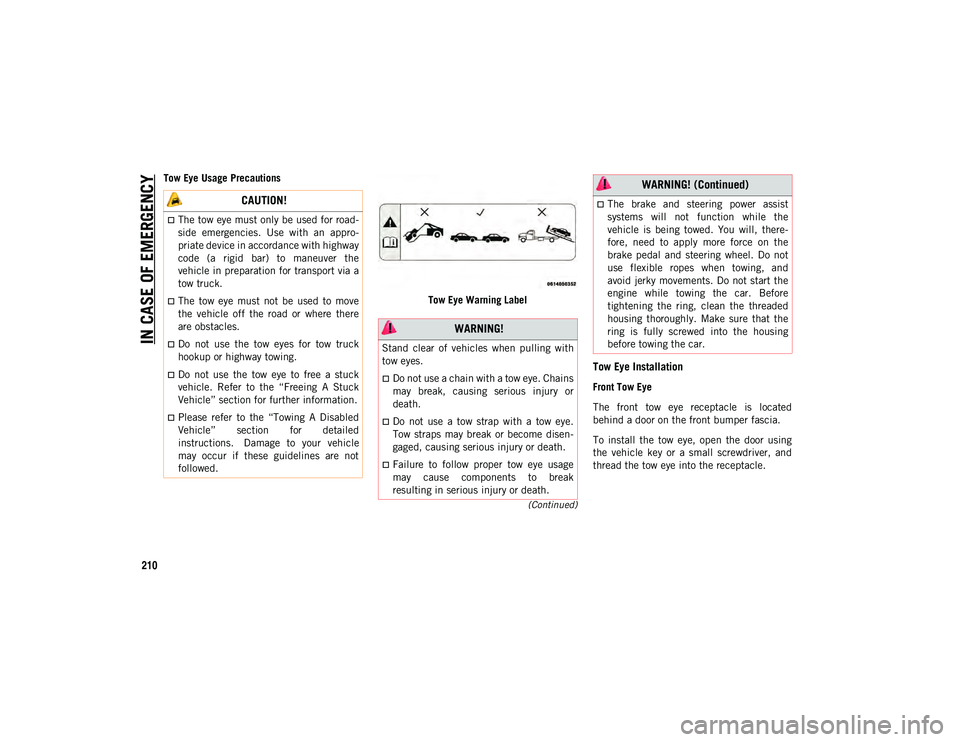
IN CASE OF EMERGENCY
210
(Continued)
Tow Eye Usage PrecautionsTow Eye Warning Label
Tow Eye Installation
Front Tow Eye
The front tow eye receptacle is located
behind a door on the front bumper fascia.
To install the tow eye, open the door using
the vehicle key or a small screwdriver, and
thread the tow eye into the receptacle.
CAUTION!
The tow eye must only be used for road-
side emergencies. Use with an appro-
priate device in accordance with highway
code (a rigid bar) to maneuver the
vehicle in preparation for transport via a
tow truck.
The tow eye must not be used to move
the vehicle off the road or where there
are obstacles.
Do not use the tow eyes for tow truck
hookup or highway towing.
Do not use the tow eye to free a stuck
vehicle. Refer to the “Freeing A Stuck
Vehicle” section for further information.
Please refer to the “Towing A Disabled
Vehicle” section for detailed
instructions. Damage to your vehicle
may occur if these guidelines are not
followed.
WARNING!
Stand clear of vehicles when pulling with
tow eyes.
Do not use a chain with a tow eye. Chains
may break, causing serious injury or
death.
Do not use a tow strap with a tow eye.
Tow straps may break or become disen -
gaged, causing serious injury or death.
Failure to follow proper tow eye usage
may cause components to break
resulting in serious injury or death.
The brake and steering power assist
systems will not function while the
vehicle is being towed. You will, there-
fore, need to apply more force on the
brake pedal and steering wheel. Do not
use flexible ropes when towing, and
avoid jerky movements. Do not start the
engine while towing the car. Before
tightening the ring, clean the threaded
housing thoroughly. Make sure that the
ring is fully screwed into the housing
before towing the car.
WARNING! (Continued)
2020_JEEP_M6_UG_UK.book Page 210
Page 215 of 328
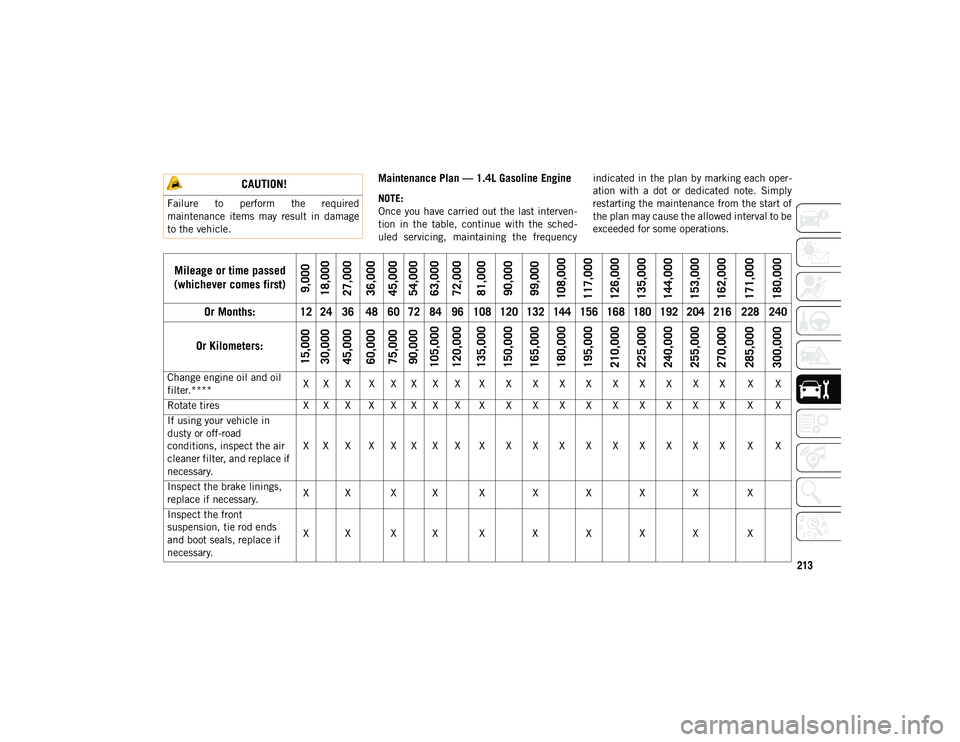
213
Maintenance Plan — 1.4L Gasoline Engine
NOTE:
Once you have carried out the last interven-
tion in the table, continue with the sched -
uled servicing, maintaining the frequency indicated in the plan by marking each oper
-
ation with a dot or dedicated note. Simply
restarting the maintenance from the start of
the plan may cause the allowed interval to be
exceeded for some operations.
CAUTION!
Failure to perform the required
maintenance items may result in damage
to the vehicle.
Mileage or time passed
(whichever comes first)
9,000
18,000
27,000
36,000
45,000
54,000
63,000
72,000
81,000
90,000
99,000
108,000
117,000
126,000
135,000
144,000
153,000
162,000
171,000
180,000
Or Months:
12 24 36 48 60 72 84 96 108 120 132 144 156 168 180 192 204 216 228 240
Or Kilometers:
15,000
30,000
45,000
60,000
75,000
90,000
105,000
120,000
135,000
150,000
165,000
180,000
195,000
210,000
225,000
240,000
255,000
270,000
285,000
300,000
Change engine oil and oil
filter.**** X X X X X X X X X X X X X X X X X X X X
Rotate tires X X X X X X X X X X X X X X X X X X X X
If using your vehicle in
dusty or off-road
conditions, inspect the air
cleaner filter, and replace if
necessary. X X X X X X X X X X X X X X X X X X X X
Inspect the brake linings,
replace if necessary. X X X X X X X X X X
Inspect the front
suspension, tie rod ends
and boot seals, replace if
necessary. X X X X X X X X X X
2020_JEEP_M6_UG_UK.book Page 213
Page 220 of 328
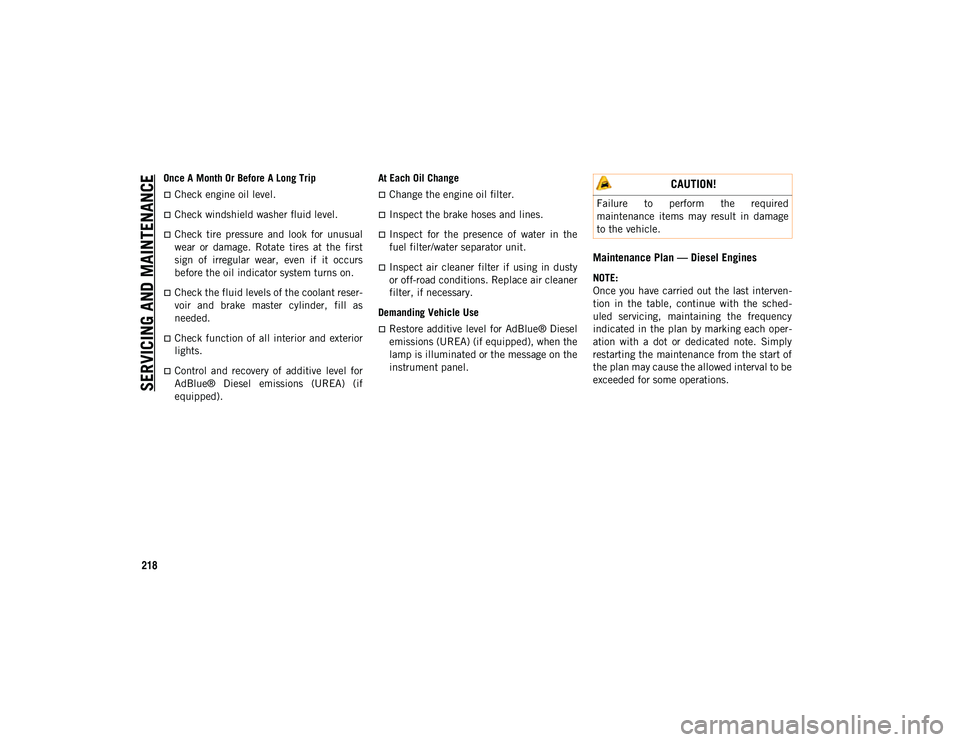
SERVICING AND MAINTENANCE
218
Once A Month Or Before A Long Trip
Check engine oil level.
Check windshield washer fluid level.
Check tire pressure and look for unusual
wear or damage. Rotate tires at the first
sign of irregular wear, even if it occurs
before the oil indicator system turns on.
Check the fluid levels of the coolant reser-
voir and brake master cylinder, fill as
needed.
Check function of all interior and exterior
lights.
Control and recovery of additive level for
AdBlue® Diesel emissions (UREA) (if
equipped). At Each Oil Change
Change the engine oil filter.
Inspect the brake hoses and lines.
Inspect for the presence of water in the
fuel filter/water separator unit.
Inspect air cleaner filter if using in dusty
or off-road conditions. Replace air cleaner
filter, if necessary.
Demanding Vehicle Use
Restore additive level for AdBlue® Diesel
emissions (UREA) (if equipped), when the
lamp is illuminated or the message on the
instrument panel.
Maintenance Plan — Diesel Engines
NOTE:
Once you have carried out the last interven -
tion in the table, continue with the sched -
uled servicing, maintaining the frequency
indicated in the plan by marking each oper -
ation with a dot or dedicated note. Simply
restarting the maintenance from the start of
the plan may cause the allowed interval to be
exceeded for some operations.
CAUTION!
Failure to perform the required
maintenance items may result in damage
to the vehicle.
2020_JEEP_M6_UG_UK.book Page 218
Page 227 of 328
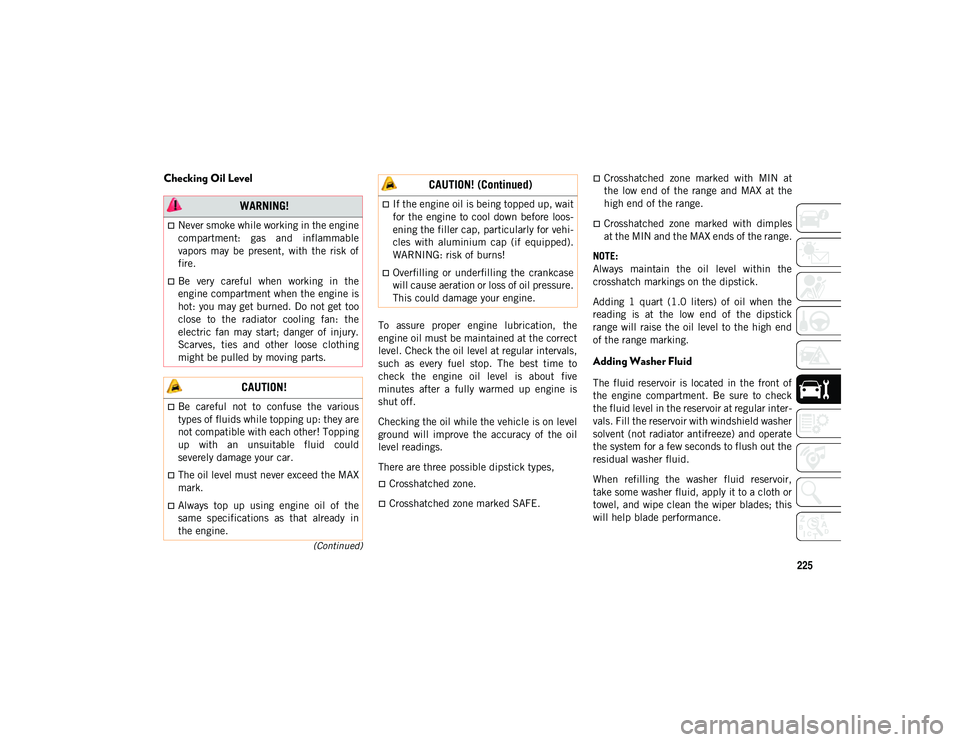
225
(Continued)
Checking Oil Level
To assure proper engine lubrication, the
engine oil must be maintained at the correct
level. Check the oil level at regular intervals,
such as every fuel stop. The best time to
check the engine oil level is about five
minutes after a fully warmed up engine is
shut off.
Checking the oil while the vehicle is on level
ground will improve the accuracy of the oil
level readings.
There are three possible dipstick types,
Crosshatched zone.
Crosshatched zone marked SAFE.
Crosshatched zone marked with MIN at
the low end of the range and MAX at the
high end of the range.
Crosshatched zone marked with dimples
at the MIN and the MAX ends of the range.
NOTE:
Always maintain the oil level within the
crosshatch markings on the dipstick.
Adding 1 quart (1.0 liters) of oil when the
reading is at the low end of the dipstick
range will raise the oil level to the high end
of the range marking.
Adding Washer Fluid
The fluid reservoir is located in the front of
the engine compartment. Be sure to check
the fluid level in the reservoir at regular inter -
vals. Fill the reservoir with windshield washer
solvent (not radiator antifreeze) and operate
the system for a few seconds to flush out the
residual washer fluid.
When refilling the washer fluid reservoir,
take some washer fluid, apply it to a cloth or
towel, and wipe clean the wiper blades; this
will help blade performance.
WARNING!
Never smoke while working in the engine
compartment: gas and inflammable
vapors may be present, with the risk of
fire.
Be very careful when working in the
engine compartment when the engine is
hot: you may get burned. Do not get too
close to the radiator cooling fan: the
electric fan may start; danger of injury.
Scarves, ties and other loose clothing
might be pulled by moving parts.
CAUTION!
Be careful not to confuse the various
types of fluids while topping up: they are
not compatible with each other! Topping
up with an unsuitable fluid could
severely damage your car.
The oil level must never exceed the MAX
mark.
Always top up using engine oil of the
same specifications as that already in
the engine.
If the engine oil is being topped up, wait
for the engine to cool down before loos-
ening the filler cap, particularly for vehi -
cles with aluminium cap (if equipped).
WARNING: risk of burns!
Overfilling or underfilling the crankcase
will cause aeration or loss of oil pressure.
This could damage your engine.
CAUTION! (Continued)
2020_JEEP_M6_UG_UK.book Page 225
Page 228 of 328
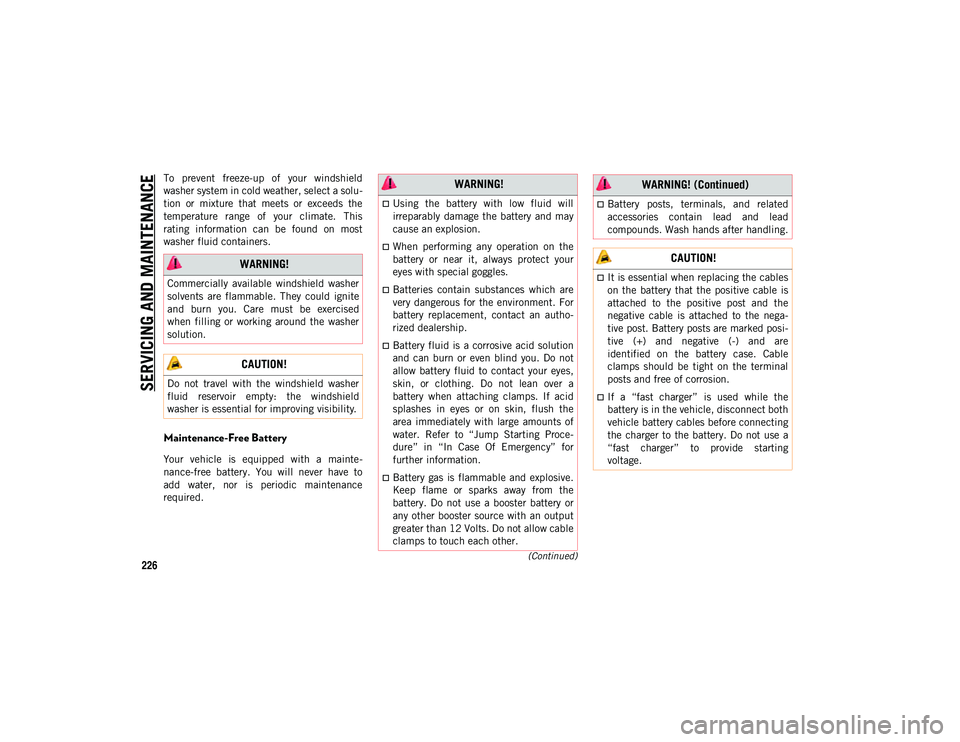
SERVICING AND MAINTENANCE
226(Continued)
To prevent freeze-up of your windshield
washer system in cold weather, select a solu-
tion or mixture that meets or exceeds the
temperature range of your climate. This
rating information can be found on most
washer fluid containers.
Maintenance-Free Battery
Your vehicle is equipped with a mainte -
nance-free battery. You will never have to
add water, nor is periodic maintenance
required.
WARNING!
Commercially available windshield washer
solvents are flammable. They could ignite
and burn you. Care must be exercised
when filling or working around the washer
solution.
CAUTION!
Do not travel with the windshield washer
fluid reservoir empty: the windshield
washer is essential for improving visibility.
WARNING!
Using the battery with low fluid will
irreparably damage the battery and may
cause an explosion.
When performing any operation on the
battery or near it, always protect your
eyes with special goggles.
Batteries contain substances which are
very dangerous for the environment. For
battery replacement, contact an autho-
rized dealership.
Battery fluid is a corrosive acid solution
and can burn or even blind you. Do not
allow battery fluid to contact your eyes,
skin, or clothing. Do not lean over a
battery when attaching clamps. If acid
splashes in eyes or on skin, flush the
area immediately with large amounts of
water. Refer to “Jump Starting Proce-
dure” in “In Case Of Emergency” for
further information.
Battery gas is flammable and explosive.
Keep flame or sparks away from the
battery. Do not use a booster battery or
any other booster source with an output
greater than 12 Volts. Do not allow cable
clamps to touch each other.
Battery posts, terminals, and related
accessories contain lead and lead
compounds. Wash hands after handling.
CAUTION!
It is essential when replacing the cables
on the battery that the positive cable is
attached to the positive post and the
negative cable is attached to the nega-
tive post. Battery posts are marked posi -
tive (+) and negative (-) and are
identified on the battery case. Cable
clamps should be tight on the terminal
posts and free of corrosion.
If a “fast charger” is used while the
battery is in the vehicle, disconnect both
vehicle battery cables before connecting
the charger to the battery. Do not use a
“fast charger” to provide starting
voltage.
WARNING! (Continued)
2020_JEEP_M6_UG_UK.book Page 226
Page 229 of 328
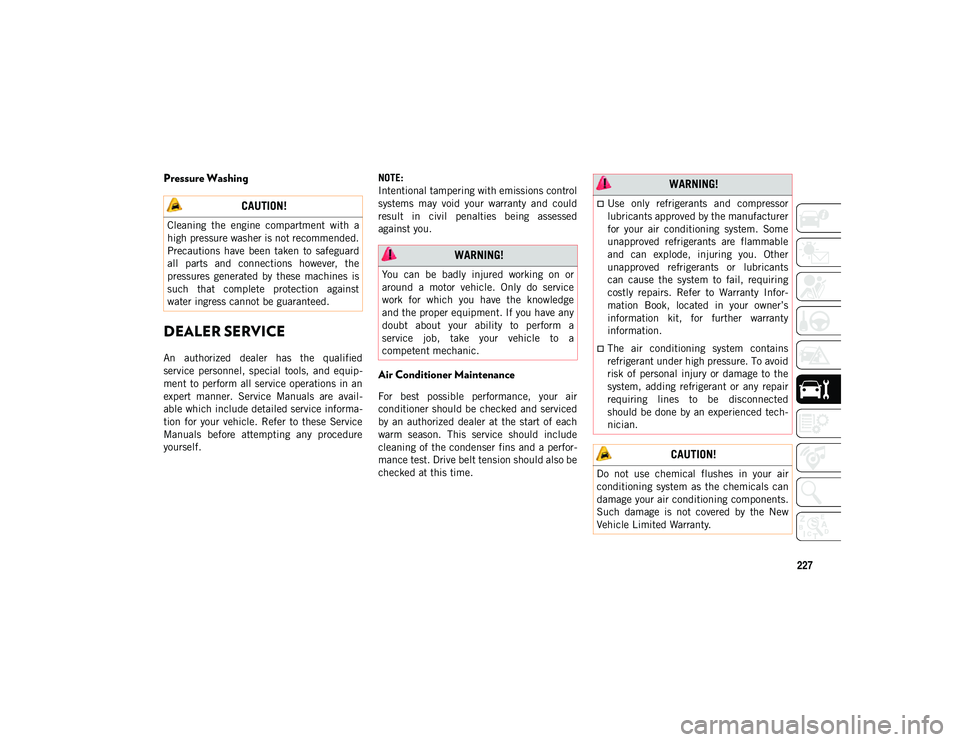
227
Pressure Washing
DEALER SERVICE
An authorized dealer has the qualified
service personnel, special tools, and equip-
ment to perform all service operations in an
expert manner. Service Manuals are avail -
able which include detailed service informa -
tion for your vehicle. Refer to these Service
Manuals before attempting any procedure
yourself. NOTE:
Intentional tampering with emissions control
systems may void your warranty and could
result in civil penalties being assessed
against you.
Air Conditioner Maintenance
For best possible performance, your air
conditioner should be checked and serviced
by an authorized dealer at the start of each
warm season. This service should include
cleaning of the condenser fins and a perfor
-
mance test. Drive belt tension should also be
checked at this time.
CAUTION!
Cleaning the engine compartment with a
high pressure washer is not recommended.
Precautions have been taken to safeguard
all parts and connections however, the
pressures generated by these machines is
such that complete protection against
water ingress cannot be guaranteed.
WARNING!
You can be badly injured working on or
around a motor vehicle. Only do service
work for which you have the knowledge
and the proper equipment. If you have any
doubt about your ability to perform a
service job, take your vehicle to a
competent mechanic.
WARNING!
Use only refrigerants and compressor
lubricants approved by the manufacturer
for your air conditioning system. Some
unapproved refrigerants are flammable
and can explode, injuring you. Other
unapproved refrigerants or lubricants
can cause the system to fail, requiring
costly repairs. Refer to Warranty Infor -
mation Book, located in your owner’s
information kit, for further warranty
information.
The air conditioning system contains
refrigerant under high pressure. To avoid
risk of personal injury or damage to the
system, adding refrigerant or any repair
requiring lines to be disconnected
should be done by an experienced tech -
nician.
CAUTION!
Do not use chemical flushes in your air
conditioning system as the chemicals can
damage your air conditioning components.
Such damage is not covered by the New
Vehicle Limited Warranty.
2020_JEEP_M6_UG_UK.book Page 227
Page 230 of 328
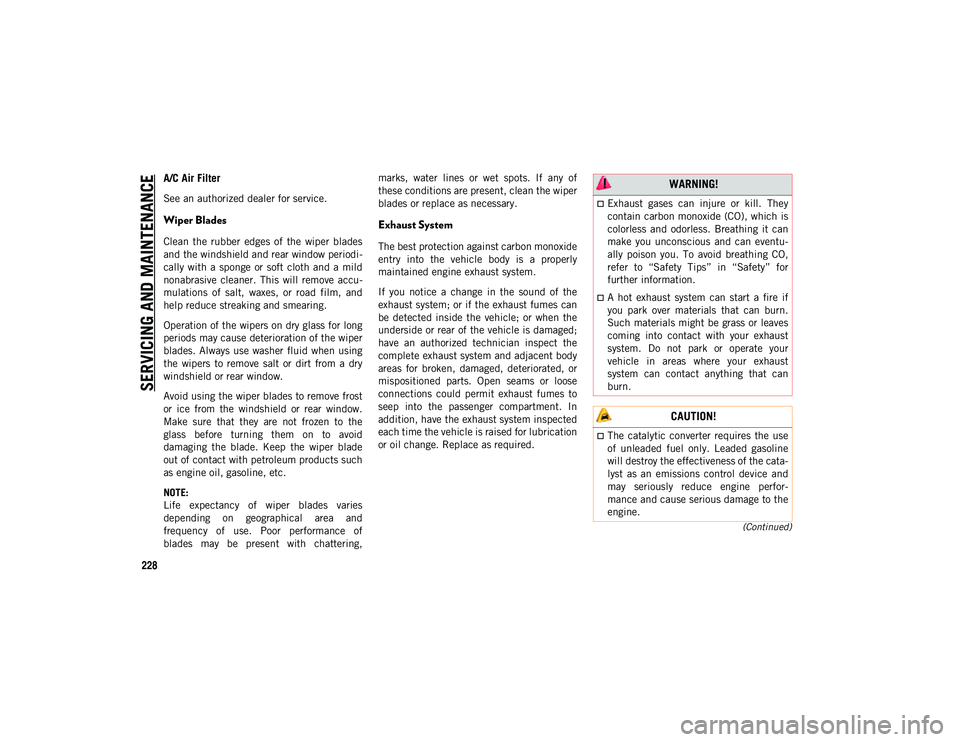
SERVICING AND MAINTENANCE
228
(Continued)
A/C Air Filter
See an authorized dealer for service.
Wiper Blades
Clean the rubber edges of the wiper blades
and the windshield and rear window periodi-
cally with a sponge or soft cloth and a mild
nonabrasive cleaner. This will remove accu -
mulations of salt, waxes, or road film, and
help reduce streaking and smearing.
Operation of the wipers on dry glass for long
periods may cause deterioration of the wiper
blades. Always use washer fluid when using
the wipers to remove salt or dirt from a dry
windshield or rear window.
Avoid using the wiper blades to remove frost
or ice from the windshield or rear window.
Make sure that they are not frozen to the
glass before turning them on to avoid
damaging the blade. Keep the wiper blade
out of contact with petroleum products such
as engine oil, gasoline, etc.
NOTE:
Life expectancy of wiper blades varies
depending on geographical area and
frequency of use. Poor performance of
blades may be present with chattering, marks, water lines or wet spots. If any of
these conditions are present, clean the wiper
blades or replace as necessary.
Exhaust System
The best protection against carbon monoxide
entry into the vehicle body is a properly
maintained engine exhaust system.
If you notice a change in the sound of the
exhaust system; or if the exhaust fumes can
be detected inside the vehicle; or when the
underside or rear of the vehicle is damaged;
have an authorized technician inspect the
complete exhaust system and adjacent body
areas for broken, damaged, deteriorated, or
mispositioned parts. Open seams or loose
connections could permit exhaust fumes to
seep into the passenger compartment. In
addition, have the exhaust system inspected
each time the vehicle is raised for lubrication
or oil change. Replace as required.
WARNING!
Exhaust gases can injure or kill. They
contain carbon monoxide (CO), which is
colorless and odorless. Breathing it can
make you unconscious and can eventu
-
ally poison you. To avoid breathing CO,
refer to “Safety Tips” in “Safety” for
further information.
A hot exhaust system can start a fire if
you park over materials that can burn.
Such materials might be grass or leaves
coming into contact with your exhaust
system. Do not park or operate your
vehicle in areas where your exhaust
system can contact anything that can
burn.
CAUTION!
The catalytic converter requires the use
of unleaded fuel only. Leaded gasoline
will destroy the effectiveness of the cata-
lyst as an emissions control device and
may seriously reduce engine perfor -
mance and cause serious damage to the
engine.
2020_JEEP_M6_UG_UK.book Page 228
Page 231 of 328
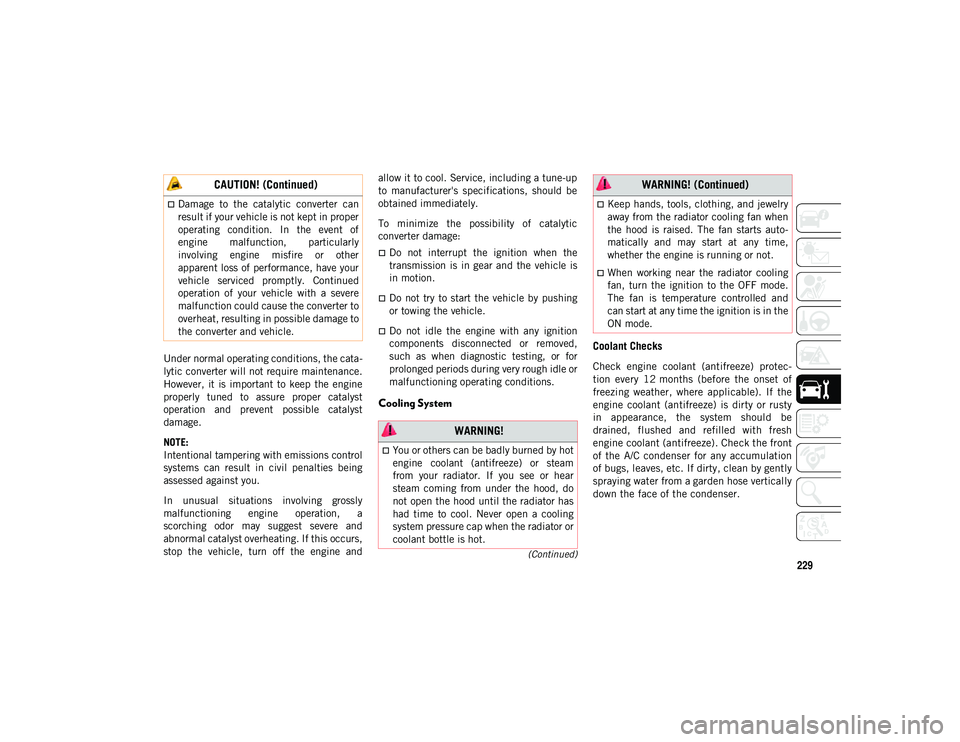
229(Continued)
Under normal operating conditions, the cata-
lytic converter will not require maintenance.
However, it is important to keep the engine
properly tuned to assure proper catalyst
operation and prevent possible catalyst
damage.
NOTE:
Intentional tampering with emissions control
systems can result in civil penalties being
assessed against you.
In unusual situations involving grossly
malfunctioning engine operation, a
scorching odor may suggest severe and
abnormal catalyst overheating. If this occurs,
stop the vehicle, turn off the engine and allow it to cool. Service, including a tune-up
to manufacturer's specifications, should be
obtained immediately.
To minimize the possibility of catalytic
converter damage:
Do not interrupt the ignition when the
transmission is in gear and the vehicle is
in motion.
Do not try to start the vehicle by pushing
or towing the vehicle.
Do not idle the engine with any ignition
components disconnected or removed,
such as when diagnostic testing, or for
prolonged periods during very rough idle or
malfunctioning operating conditions.
Cooling System
Coolant Checks
Check engine coolant (antifreeze) protec
-
tion every 12 months (before the onset of
freezing weather, where applicable). If the
engine coolant (antifreeze) is dirty or rusty
in appearance, the system should be
drained, flushed and refilled with fresh
engine coolant (antifreeze). Check the front
of the A/C condenser for any accumulation
of bugs, leaves, etc. If dirty, clean by gently
spraying water from a garden hose vertically
down the face of the condenser.
Damage to the catalytic converter can
result if your vehicle is not kept in proper
operating condition. In the event of
engine malfunction, particularly
involving engine misfire or other
apparent loss of performance, have your
vehicle serviced promptly. Continued
operation of your vehicle with a severe
malfunction could cause the converter to
overheat, resulting in possible damage to
the converter and vehicle.
CAUTION! (Continued)
WARNING!
You or others can be badly burned by hot
engine coolant (antifreeze) or steam
from your radiator. If you see or hear
steam coming from under the hood, do
not open the hood until the radiator has
had time to cool. Never open a cooling
system pressure cap when the radiator or
coolant bottle is hot.
Keep hands, tools, clothing, and jewelry
away from the radiator cooling fan when
the hood is raised. The fan starts auto-
matically and may start at any time,
whether the engine is running or not.
When working near the radiator cooling
fan, turn the ignition to the OFF mode.
The fan is temperature controlled and
can start at any time the ignition is in the
ON mode.
WARNING! (Continued)
2020_JEEP_M6_UG_UK.book Page 229
Page 239 of 328
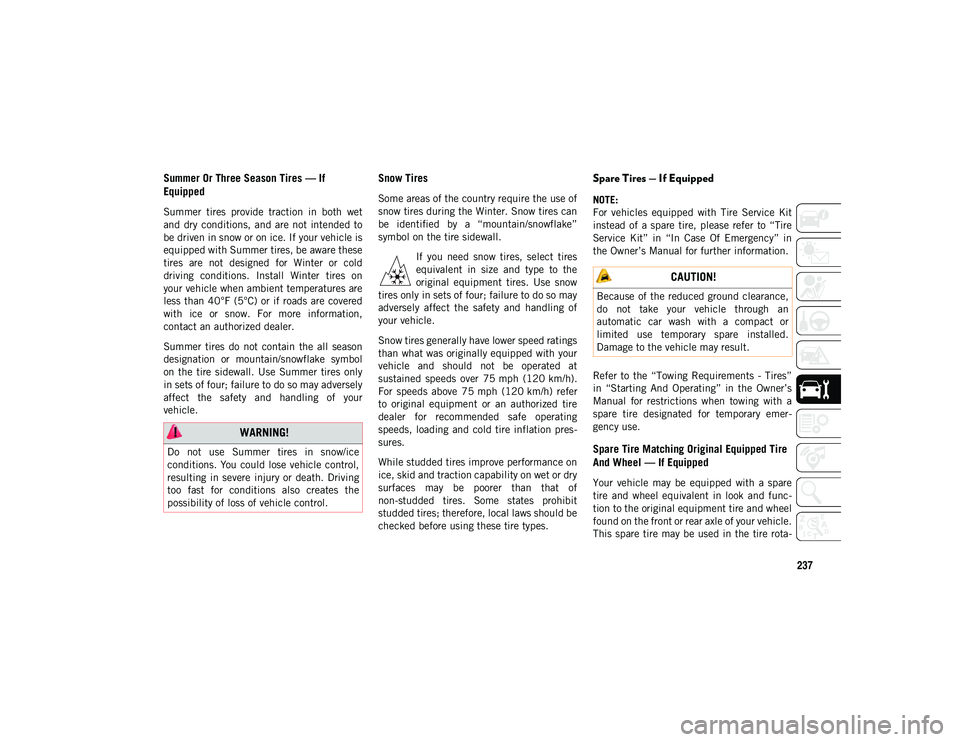
237
Summer Or Three Season Tires — If
Equipped
Summer tires provide traction in both wet
and dry conditions, and are not intended to
be driven in snow or on ice. If your vehicle is
equipped with Summer tires, be aware these
tires are not designed for Winter or cold
driving conditions. Install Winter tires on
your vehicle when ambient temperatures are
less than 40°F (5°C) or if roads are covered
with ice or snow. For more information,
contact an authorized dealer.
Summer tires do not contain the all season
designation or mountain/snowflake symbol
on the tire sidewall. Use Summer tires only
in sets of four; failure to do so may adversely
affect the safety and handling of your
vehicle.
Snow Tires
Some areas of the country require the use of
snow tires during the Winter. Snow tires can
be identified by a “mountain/snowflake”
symbol on the tire sidewall.If you need snow tires, select tires
equivalent in size and type to the
original equipment tires. Use snow
tires only in sets of four; failure to do so may
adversely affect the safety and handling of
your vehicle.
Snow tires generally have lower speed ratings
than what was originally equipped with your
vehicle and should not be operated at
sustained speeds over 75 mph (120 km/h).
For speeds above 75 mph (120 km/h) refer
to original equipment or an authorized tire
dealer for recommended safe operating
speeds, loading and cold tire inflation pres -
sures.
While studded tires improve performance on
ice, skid and traction capability on wet or dry
surfaces may be poorer than that of
non-studded tires. Some states prohibit
studded tires; therefore, local laws should be
checked before using these tire types.
Spare Tires — If Equipped
NOTE:
For vehicles equipped with Tire Service Kit
instead of a spare tire, please refer to “Tire
Service Kit” in “In Case Of Emergency” in
the Owner’s Manual for further information.
Refer to the “Towing Requirements - Tires”
in “Starting And Operating” in the Owner’s
Manual for restrictions when towing with a
spare tire designated for temporary emer -
gency use.
Spare Tire Matching Original Equipped Tire
And Wheel — If Equipped
Your vehicle may be equipped with a spare
tire and wheel equivalent in look and func -
tion to the original equipment tire and wheel
found on the front or rear axle of your vehicle.
This spare tire may be used in the tire rota -
WARNING!
Do not use Summer tires in snow/ice
conditions. You could lose vehicle control,
resulting in severe injury or death. Driving
too fast for conditions also creates the
possibility of loss of vehicle control.
CAUTION!
Because of the reduced ground clearance,
do not take your vehicle through an
automatic car wash with a compact or
limited use temporary spare installed.
Damage to the vehicle may result.
2020_JEEP_M6_UG_UK.book Page 237
Page 243 of 328
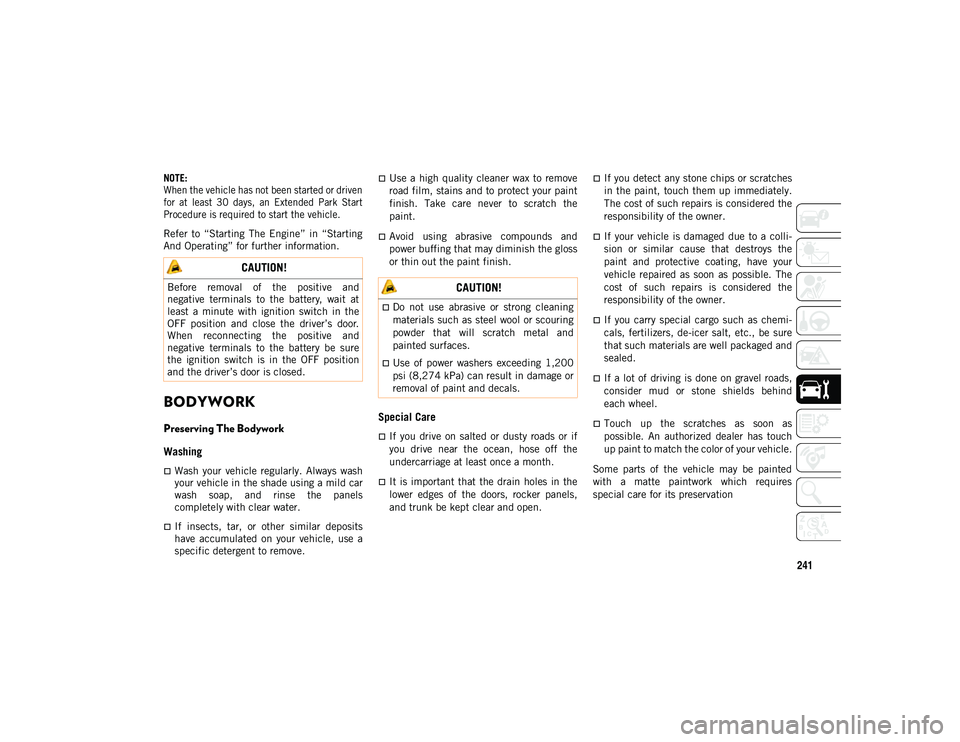
241
NOTE:
When the vehicle has not been started or driven
for at least 30 days, an Extended Park Start
Procedure is required to start the vehicle.
Refer to “Starting The Engine” in “Starting
And Operating” for further information.
BODYWORK
Preserving The Bodywork
Washing
Wash your vehicle regularly. Always wash
your vehicle in the shade using a mild car
wash soap, and rinse the panels
completely with clear water.
If insects, tar, or other similar deposits
have accumulated on your vehicle, use a
specific detergent to remove.
Use a high quality cleaner wax to remove
road film, stains and to protect your paint
finish. Take care never to scratch the
paint.
Avoid using abrasive compounds and
power buffing that may diminish the gloss
or thin out the paint finish.
Special Care
If you drive on salted or dusty roads or if
you drive near the ocean, hose off the
undercarriage at least once a month.
It is important that the drain holes in the
lower edges of the doors, rocker panels,
and trunk be kept clear and open.
If you detect any stone chips or scratches
in the paint, touch them up immediately.
The cost of such repairs is considered the
responsibility of the owner.
If your vehicle is damaged due to a colli-
sion or similar cause that destroys the
paint and protective coating, have your
vehicle repaired as soon as possible. The
cost of such repairs is considered the
responsibility of the owner.
If you carry special cargo such as chemi -
cals, fertilizers, de-icer salt, etc., be sure
that such materials are well packaged and
sealed.
If a lot of driving is done on gravel roads,
consider mud or stone shields behind
each wheel.
Touch up the scratches as soon as
possible. An authorized dealer has touch
up paint to match the color of your vehicle.
Some parts of the vehicle may be painted
with a matte paintwork which requires
special care for its preservation
CAUTION!
Before removal of the positive and
negative terminals to the battery, wait at
least a minute with ignition switch in the
OFF position and close the driver’s door.
When reconnecting the positive and
negative terminals to the battery be sure
the ignition switch is in the OFF position
and the driver’s door is closed. CAUTION!
Do not use abrasive or strong cleaning
materials such as steel wool or scouring
powder that will scratch metal and
painted surfaces.
Use of power washers exceeding 1,200
psi (8,274 kPa) can result in damage or
removal of paint and decals.
2020_JEEP_M6_UG_UK.book Page 241